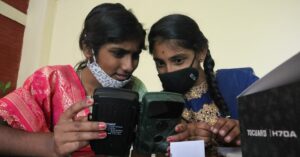Decoys, Stings & More: How Haryana Is Cracking Its Whip To Improve Its Sex Ratio
Haryana's crackdown on the scourge of female foeticide has seen its sex ratio rise from 830 to 928. We decode the efforts that have borne this fruit.

When India held its last census in 2011, Haryana had the worst sex ratio at birth (SBM) in the country at 830. In other words, for every 1,000 males, only 830 females were born. Matters didn’t improve significantly by 2014 when the sex ration stood at a dismal 871.
By 2017, however, Haryana’s sex ratio showed a marked increase to 914, according to a joint study conducted by PGI Hospital, Chandigarh, the Haryana government and consulting firm, IPE Global.
The results of their study were published earlier this year in the ‘Health Policy and Planning’ journal of the London School of Hygiene and Tropical Medicine. However, the latest figure published by the Haryana government as of March 2018 stands at 928.
Even though the Pre-Conception and Pre-Natal Diagnostic Techniques (Prohibition of Sex Selection) Act, 1994, which banned prenatal sex determination and punished anyone indulging in such practices with a jail term and fine, has been in force since 1996, little had changed in some of the worst-affected states.
The situation began to change rapidly after 2015 when the Centre announced its flagship ‘Beti Bachao, Beti Padhao’ scheme and the Haryana government started to heavily clamp down on those running sex determination centres in the state utilising provisions in the PCPNDT Act and Medical Termination of Pregnancy (MTP) Act.
A look at the district-wise breakdown of results offers a clearer picture of the impact that comes with better enforcement of the law and a publicity blitzkrieg defending the girl child.

According to the Haryana government, in 2012 five districts had a sex ratio below 800, namely Rewari (780), Narnaul (770), Kurukshetra (743), Jhajjar (781) and Karnal (797). In 2017, there were just four districts that registered a sex ratio below 900, namely Rewari (893), Rohtak (891), Jind (898) and Narnaul (881). Districts like Kurukshetra, meanwhile, have seen their sex ratio rise to 924 in 2017, and Mewat today has seen more girls born than boys.
Going by multiple reports, it seems evident that the secret to the Haryana government’s success has been better enforcement of the law since the launch of the BBBP scheme.
According to a joint study cited earlier (Effectiveness of India’s National Programme to save the girl child: Experience of Bet Bachao Beti Padhao programme from Haryana state) in the first 12 months since the scheme’s launch, more than 250 FIRs were registered while 200 persons indulging in such practices including doctors, quacks, parents and their relatives have been arrested under the PCPNDT and MTP Acts.
According to The Indian Express, “Decoy pregnant female customers seeking sex determination played an important role in their arrests. The state police also collaborated with enforcement agencies from neighbouring states to nab the culprits.”
“Enforcement is the key to the solution. And we have focussed on that,” said Dr Girdhari Lal Singal, in-charge of the programme in Haryana, speaking to The Print. “Apart from conducting stings, our district teams have become trained to follow these cases in courts to ensure conviction,” said Singal.
However, according to the same report, authorities in Haryana are unhappy with the ineffectiveness of their counterparts in Punjab in cracking down on sex determination centres. Families from Haryana often travel to the neighbouring state, evading local authorities. Officials in Punjab refute the charge and argue that Haryana counterparts have no jurisdiction to conduct sting operations.
Also Read: Why a 14-YO Haryana Girl Is Giving Motivational Speeches to IAS Officers!
“Our study is the first evidence, which points towards the beneficial effect of a comprehensive regulatory policy to curb the sex selective abortion in India,” says Shankar Prinja from School of Public Health, Post Graduate Institute of Medical Education and Research (PGIMER), Chandigarh, in the study, speaking to The Indian Express. “If the campaign was not launched effectively, virtually, there would not have any significant impact on the sex ratio at birth.”
Haryana’s battle against its dwindling sex ratio is finally producing some encouraging results. Having said that, the state still has some way to go before it can even match the national average of 943, or possibly reach level terms with some of India’s more progressive states like Kerala (1084 in 2011) and Tamil Nadu (996 in 2011).
(Edited by Gayatri Mishra)
Like this story? Or have something to share? Write to us: [email protected], or connect with us on Facebook and Twitter.

Similar Story

This Software Company Has Invested $5 Million To Make Quality Education Accessible to All
To ensure that untapped talent can build social capital, Salesforce is providing a holistic support to school and high school students with better access to quality education and career counselling platforms.
Read more >
If you found our stories insightful, informative, or even just enjoyable, we invite you to consider making a voluntary payment to support the work we do at The Better India. Your contribution helps us continue producing quality content that educates, inspires, and drives positive change.
Choose one of the payment options below for your contribution-
By paying for the stories you value, you directly contribute to sustaining our efforts focused on making a difference in the world. Together, let's ensure that impactful stories continue to be told and shared, enriching lives and communities alike.
Thank you for your support. Here are some frequently asked questions you might find helpful to know why you are contributing?


This story made me
-
97
-
121
-
89
-
167












